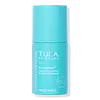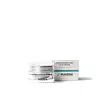What's inside
What's inside
 Key Ingredients
Key Ingredients

 Benefits
Benefits

 Concerns
Concerns

 Ingredients Side-by-side
Ingredients Side-by-side

Water
Skin ConditioningPropanediol
SolventC15-19 Alkane
SolventGlycerin
Humectant1,2-Hexanediol
Skin ConditioningLactococcus Ferment Lysate
Skin ConditioningPentylene Glycol
Skin ConditioningCetyl Alcohol
EmollientChlorella Vulgaris Extract
Skin ConditioningVaccinium Macrocarpon Fruit Extract
AstringentTridecapeptide-1
Skin ConditioningCeramide AP
Skin ConditioningCeramide As
Skin ConditioningCeramide Ns
Skin ConditioningCeramide EOP
Skin ConditioningCeramide NP
Skin ConditioningSodium Hyaluronate
HumectantHydrolyzed Sodium Hyaluronate
Skin ConditioningSodium Acetylated Hyaluronate
HumectantSodium Hyaluronate Crosspolymer
HumectantAloe Barbadensis Leaf Juice
Skin ConditioningLactobacillus
Skin ConditioningCurcuma Longa Root Extract
MaskingLactobacillus Ferment
Skin ConditioningBeta Vulgaris Root Extract
Skin ConditioningRetinal
Skin ConditioningArginine
MaskingDiisostearyl Malate
EmollientAlpha-Glucan Oligosaccharide
CleansingBisabolol
MaskingInulin
Skin ConditioningArachidyl Alcohol
EmollientLactic Acid
BufferingSclerotium Gum
Emulsion StabilisingCitric Acid
BufferingBehenyl Alcohol
EmollientMalic Acid
BufferingPolymnia Sonchifolia Root Juice
Skin ConditioningArachidyl Glucoside
EmulsifyingHydrogenated Lecithin
EmulsifyingPolyacrylate Crosspolymer-6
Emulsion StabilisingCellulose Gum
Emulsion StabilisingGlucose
HumectantCalcium Chloride
AstringentFructose
HumectantCholesterol
EmollientSodium Phytate
2,3-Butanediol
HumectantCalcium Alginate
MaskingGlyceryl Stearate
EmollientLecithin
EmollientCellulose
AbsorbentSodium Hydroxide
BufferingEthylhexylglycerin
Skin ConditioningCaprylyl Glycol
EmollientMaltodextrin
AbsorbentXanthan Gum
EmulsifyingSodium Benzoate
MaskingButylene Glycol
HumectantSodium Chloride
MaskingPotassium Sorbate
PreservativeWater, Propanediol, C15-19 Alkane, Glycerin, 1,2-Hexanediol, Lactococcus Ferment Lysate, Pentylene Glycol, Cetyl Alcohol, Chlorella Vulgaris Extract, Vaccinium Macrocarpon Fruit Extract, Tridecapeptide-1, Ceramide AP, Ceramide As, Ceramide Ns, Ceramide EOP, Ceramide NP, Sodium Hyaluronate, Hydrolyzed Sodium Hyaluronate, Sodium Acetylated Hyaluronate, Sodium Hyaluronate Crosspolymer, Aloe Barbadensis Leaf Juice, Lactobacillus, Curcuma Longa Root Extract, Lactobacillus Ferment, Beta Vulgaris Root Extract, Retinal, Arginine, Diisostearyl Malate, Alpha-Glucan Oligosaccharide, Bisabolol, Inulin, Arachidyl Alcohol, Lactic Acid, Sclerotium Gum, Citric Acid, Behenyl Alcohol, Malic Acid, Polymnia Sonchifolia Root Juice, Arachidyl Glucoside, Hydrogenated Lecithin, Polyacrylate Crosspolymer-6, Cellulose Gum, Glucose, Calcium Chloride, Fructose, Cholesterol, Sodium Phytate, 2,3-Butanediol, Calcium Alginate, Glyceryl Stearate, Lecithin, Cellulose, Sodium Hydroxide, Ethylhexylglycerin, Caprylyl Glycol, Maltodextrin, Xanthan Gum, Sodium Benzoate, Butylene Glycol, Sodium Chloride, Potassium Sorbate
Water
Skin ConditioningC12-15 Alkyl Benzoate
AntimicrobialCetyl Ricinoleate
EmollientSorbitol
HumectantGlycerin
HumectantC12-20 Acid PEG-8 Ester
EmulsifyingSorbitan Stearate
EmulsifyingGlyceryl Stearate
EmollientPEG-100 Stearate
Carthamus Tinctorius Seed Oil
MaskingSodium Potassium Aluminum Silicate
Glycolic Acid
BufferingMyristoyl Pentapeptide-8
Skin ConditioningMyristoyl Pentapeptide-11
Skin ConditioningSh-Polypeptide-9
Skin ConditioningSh-Polypeptide-22
Skin ConditioningSh-Oligopeptide-4
Skin ConditioningAloe Barbadensis Leaf Juice
Skin ConditioningSodium Hyaluronate
HumectantSaccharomyces Cerevisiae Extract
Skin ConditioningChamomilla Recutita Flower Extract
MaskingAleurites Moluccanus Seed Oil
Skin ConditioningMacadamia Ternifolia Seed Oil
EmollientRosmarinus Officinalis Leaf Extract
AntimicrobialRetinyl Palmitate
Skin ConditioningCamellia Sinensis Leaf Extract
AntimicrobialSaccharum Officinarum Extract
MoisturisingCitrus Medica Limonum Fruit Extract
Skin ConditioningCitrus Aurantium Dulcis Fruit Extract
MaskingPyrus Malus Pulp Extract
Skin ConditioningRetinyl Palmitate/Carrot Polypeptide
Skin ConditioningAscorbyl Palmitate
AntioxidantAscorbic Acid
AntioxidantCitric Acid
BufferingTocopherol
AntioxidantLecithin
EmollientHydrogenated Phosphatidylcholine
EmulsifyingSodium Hydroxide
BufferingPEG-8
HumectantXanthan Gum
EmulsifyingSodium Oleate
CleansingGlycine Soja Oil
EmollientParfum
MaskingLimonene
PerfumingLinalool
PerfumingSilica
AbrasiveDisodium EDTA
Caprylyl Glycol
EmollientEthylhexylglycerin
Skin ConditioningHexylene Glycol
EmulsifyingBenzoic Acid
MaskingPhenoxyethanol
PreservativeCI 40800
Cosmetic ColorantCI 77891
Cosmetic ColorantWater, C12-15 Alkyl Benzoate, Cetyl Ricinoleate, Sorbitol, Glycerin, C12-20 Acid PEG-8 Ester, Sorbitan Stearate, Glyceryl Stearate, PEG-100 Stearate, Carthamus Tinctorius Seed Oil, Sodium Potassium Aluminum Silicate, Glycolic Acid, Myristoyl Pentapeptide-8, Myristoyl Pentapeptide-11, Sh-Polypeptide-9, Sh-Polypeptide-22, Sh-Oligopeptide-4, Aloe Barbadensis Leaf Juice, Sodium Hyaluronate, Saccharomyces Cerevisiae Extract, Chamomilla Recutita Flower Extract, Aleurites Moluccanus Seed Oil, Macadamia Ternifolia Seed Oil, Rosmarinus Officinalis Leaf Extract, Retinyl Palmitate, Camellia Sinensis Leaf Extract, Saccharum Officinarum Extract, Citrus Medica Limonum Fruit Extract, Citrus Aurantium Dulcis Fruit Extract, Pyrus Malus Pulp Extract, Retinyl Palmitate/Carrot Polypeptide, Ascorbyl Palmitate, Ascorbic Acid, Citric Acid, Tocopherol, Lecithin, Hydrogenated Phosphatidylcholine, Sodium Hydroxide, PEG-8, Xanthan Gum, Sodium Oleate, Glycine Soja Oil, Parfum, Limonene, Linalool, Silica, Disodium EDTA, Caprylyl Glycol, Ethylhexylglycerin, Hexylene Glycol, Benzoic Acid, Phenoxyethanol, CI 40800, CI 77891
Ingredients Explained
These ingredients are found in both products.
Ingredients higher up in an ingredient list are typically present in a larger amount.
Aloe Barbadensis Leaf Juice comes from leaves of the aloe plant. Aloe Barbadensis Leaf Juice is best known for helping to soothe sunburns. It is also anti-inflammatory, moisturizing, antiseptic, and can help heal wounds.
Aloe is packed with good stuff including Vitamins A, C, and E. These vitamins are antioxidants, which help fight free-radicals and the damage they may cause. Free-radicals are molecules that may damage your skin cells, such as pollution.
Aloe Barbadensis Leaf Juice also contains sugars. These sugars come in the form of monosaccharides and polysaccharides, folic acid, and choline. These sugars are able to help bind moisture to skin.
It also contains minerals such as calcium, 12 anthraquinones, fatty acids, amino acids, and Vitamin B12.
Learn more about Aloe Barbadensis Leaf JuiceCaprylyl Glycol is a humectant and emollient, meaning it attracts and preserves moisture.
It is a common ingredient in many products, especially those designed to hydrate skin. The primary benefits are retaining moisture, skin softening, and promoting a healthy skin barrier.
Though Caprylyl Glycol is an alcohol derived from fatty acids, it is not the kind that can dry out skin.
This ingredient is also used as a preservative to extend the life of products. It has slight antimicrobial properties.
Learn more about Caprylyl GlycolCitric Acid is an alpha hydroxy acid (AHA) naturally found in citrus fruits like oranges, lemons, and limes.
Like other AHAs, citric acid can exfoliate skin by breaking down the bonds that hold dead skin cells together. This helps reveal smoother and brighter skin underneath.
However, this exfoliating effect only happens at high concentrations (20%) which can be hard to find in cosmetic products.
Due to this, citric acid is usually included in small amounts as a pH adjuster. This helps keep products slightly more acidic and compatible with skin's natural pH.
In skincare formulas, citric acid can:
While it can provide some skin benefits, research shows lactic acid and glycolic acid are generally more effective and less irritating exfoliants.
Most citric acid used in skincare today is made by fermenting sugars (usually from molasses). This synthetic version is identical to the natural citrus form but easier to stabilize and use in formulations.
Read more about some other popular AHA's here:
Learn more about Citric AcidEthylhexylglycerin (we can't pronounce this either) is commonly used as a preservative and skin softener. It is derived from glyceryl.
You might see Ethylhexylglycerin often paired with other preservatives such as phenoxyethanol. Ethylhexylglycerin has been found to increase the effectiveness of these other preservatives.
Glycerin is already naturally found in your skin. It helps moisturize and protect your skin.
A study from 2016 found glycerin to be more effective as a humectant than AHAs and hyaluronic acid.
As a humectant, it helps the skin stay hydrated by pulling moisture to your skin. The low molecular weight of glycerin allows it to pull moisture into the deeper layers of your skin.
Hydrated skin improves your skin barrier; Your skin barrier helps protect against irritants and bacteria.
Glycerin has also been found to have antimicrobial and antiviral properties. Due to these properties, glycerin is often used in wound and burn treatments.
In cosmetics, glycerin is usually derived from plants such as soybean or palm. However, it can also be sourced from animals, such as tallow or animal fat.
This ingredient is organic, colorless, odorless, and non-toxic.
Glycerin is the name for this ingredient in American English. British English uses Glycerol/Glycerine.
Learn more about GlycerinGlyceryl Stearate is a mix of glycerin and stearic acid.
It is used to stabilize the mixing of water and oil ingredients. By preventing these ingredients from separating, it can help elongate shelf life. It can also help thicken the product's texture.
As an emollient, it helps soften skin and supports barrier-replenishing ingredients.
In cosmetics, Glyceryl Stearate is often made from vegetable oils or synthetically produced.
This ingredient may not be fungal-acne safe
Fun fact: The human body also creates Glyceryl Stearate naturally.
Learn more about Glyceryl StearateLecithin is a term for a group of substances found in the cell membranes of plants, animals, and humans. They are made up of mixture of phospholipids.
This ingredient has emollient and emulsifying properties.
As an emollient, lecithen helps soften the skin and creates a barrier to keep moisture in.
As an emulsifier, it also helps prevent water and oil ingredients from separating. Lecithin can also help ingredients be better absorbed by the skin.
This is because the phospholipids in lecithin produce liposomes. Liposomes help other ingredients get through the skin barrier.
Depending on the source of this ingredient, lecithin may not be fungal acne safe. This is because some sources of lecithin come from soybean oil, which may feed the malassezia yeast that feeds fungal acne.
We recommend reaching out to the brand you are purchasing from to inquire about the source of their lecithin.
Some other names for this ingredient include soy lecithin and deoiled soy lecithin.
Learn more about LecithinSodium Hyaluronate is hyaluronic acid's salt form. It is commonly derived from the sodium salt of hyaluronic acid.
Like hyaluronic acid, it is great at holding water and acts as a humectant. This makes it a great skin hydrating ingredient.
Sodium Hyaluronate is naturally occurring in our bodies and is mostly found in eye fluid and joints.
These are some other common types of Hyaluronic Acid:
Learn more about Sodium HyaluronateSodium Hydroxide is also known as lye or caustic soda. It is used to adjust the pH of products; many ingredients require a specific pH to be effective.
In small amounts, sodium hydroxide is considered safe to use. However, large amounts may cause chemical burns due to its high alkaline.
Your skin has a natural pH and acid mantle. This acid mantle helps prevent harmful bacteria from breaking through. The acid mantle also helps keep your skin hydrated.
"Alkaline" refers to a high pH level. A low pH level would be considered acidic.
Learn more about Sodium HydroxideWater. It's the most common cosmetic ingredient of all. You'll usually see it at the top of ingredient lists, meaning that it makes up the largest part of the product.
So why is it so popular? Water most often acts as a solvent - this means that it helps dissolve other ingredients into the formulation.
You'll also recognize water as that liquid we all need to stay alive. If you see this, drink a glass of water. Stay hydrated!
Learn more about WaterXanthan gum is used as a stabilizer and thickener within cosmetic products. It helps give products a sticky, thick feeling - preventing them from being too runny.
On the technical side of things, xanthan gum is a polysaccharide - a combination consisting of multiple sugar molecules bonded together.
Xanthan gum is a pretty common and great ingredient. It is a natural, non-toxic, non-irritating ingredient that is also commonly used in food products.
Learn more about Xanthan Gum